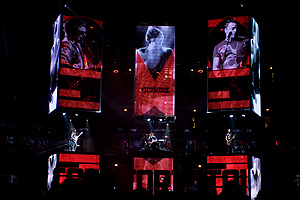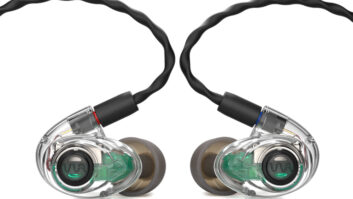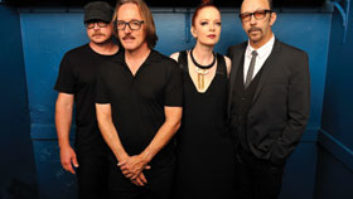
Muse is a band with its eyes set on the stage. Since the band’s debut studio album in 1998, it seems that the bandmembers’ moody, fantastical, prog-laden music has been tailor-made for mind-blowing live shows. From their 2007/2008 tour for Black Holes and Revelations, they were honored with numerous awards for Best Live Act by NME and others. Following that tour, they went back to recording, and as their newest release, Uprising, came to life in the studio, the vision for their new live show also germinated.
Playing a show in the round at Royal Albert Hall during that last tour sparked an idea. The band loved having the audience all around them, but they wanted every person in the audience to experience all of the performance’s sights and sounds. The round stage is equipped with three square hydraulic risers that lift each bandmember some 20 feet up. Each riser is met by a four-sided rigging from above, and the risers and upper riggings are both swathed in LED video. During parts of the show, the lifts bring the musicians down to stage level, and singer/guitarist Matt Bellamy and bassist Chris Wolstenholme make use of stationary risers on the sides of the stage to make contact with the fans. Though in a fixed position in center stage, drummer Dominic Howard and his kit sit atop a riser on a rotating disc so that he, too, can connect with the crowd.
BRING IN THE SOUND
Once the stage design was sketched out, system engineer Paddy Hocken and front-of-house engineer Marc Carolan assembled an audio package (supplied by UK-based Skan PA Hire) that would deliver the sound in the round. Wanting to provide a consistent 360-degree scenario, they spec’d d&b’s J Series and Q Series. They’re using the same speakers all the way around the stage in right- and left-front hangs, and side hangs; around the back, a 270-degree hang and 360-degree hang are on each side. Each fill comprises a blend of J8s and J12s. The center hang comprises six d&b Q1 two-way speakers. Around the back, they use more of the wider-dispersion J boxes to get the coverage and because the audience is very close to the hangs. In some instances (where weight and trim allow), they fly J-SUBs above the hangs to enhance low end in the back seats.
Beneath the stage, 18 J-SUBs are arranged in an arc array. Carolan is very pleased with the J-SUBs’ ability to pump out time- and phase-controlled low end without building up any sub pockets, as well as keeping the stage above isolated from excessive vibration. A handful of Q10 two-way speakers are stacked with the sub array to fill gaps in the lower parts of the arena. To give full, even coverage in the pit, Carolan arrays the center hang in a combed pattern, angling the Q10s alternately left and right. He puts up only one left/right mix instead of adding discrete mixes for the center cluster or other zones. “I used to use a mono center cluster, but when instruments were panned, they sometimes created a build-up in the center area,” Carolan explains.
Hocken is using Ascendo Room Tools to time-align the system. “We get a very small window of opportunity to make noise, perhaps 15 minutes to check with CDs,” Hocken explains. The Ascendo system produces only a discrete, sweeping “whoop” tone that is almost silent. “I can get to that any time in the day, and it only takes about half an hour,” Hocken continues. “I don’t have to ask permission to make noise because it ramps up slowly. If someone’s in the air, they’re not going to get stunned by it.” Afterward, he can make good use of that 15-minute window to properly listen to music.
At FOH, EAW Smaart 5 is running, overlayed via the Dolby Lake Analyzer Bridge onto the Dolby Lake Controller that serves as the system’s main EQ. Carolan and Hocken don’t rely heavily on this aspect of the system as they’re playing virtually identical arenas and because the J line has proven to be so consistent.
The d&b system is powered by 96 D12 amplifiers. They use the Apogee Rosetta 800 for A/D conversion coming out of the Midas XL4 FOH console. This then feeds through the Dolby Lake EQ before going out to the D12s as an AES/EBU 96kHz signal. In case of system failure, they are equipped with fully redundant Apogee and Dolby Lake components, and the D12s are also wired with analog inputs.
BACK TO THE BAND
Muse’s music is at once distortion-laden and crystal-clear—they get a big, big sound for a three-piece. (They do tour with the addition of keyboardist Morgan Nichols to fill things out.) When Mix stopped by the tour at Chicago’s United Center, we asked Carolan how he achieves good separation as the band uses distortion on guitar, bass and vocals. Carolan answers: “Using very different mics on each thing supports the character of the individual instruments, making it all gel while defining everything.”
On bass, Wolstenholme plays through two rigs. His “clean” rig is set up with a Beyerdynamic M88 and a DI on the back of the head. For the distorted rig, Carolan places a Shure SM7 about six inches from the cone because the mic handles the grunt of the distortion, even with heavy gain.
Drum miking is in a standard configuration, though Carolan uses a Neumann KM105 for snare bottom. He says it was a happy accident when he discovered that the KM105, although mainly a vocal mic, gives the snare a nice balance between low rattle and high-end ping, and the shape of the mic makes for easy positioning.
Frontman Bellamy designs his own guitars, which are custom-built by Hugh Manson. These masterpieces have lots of built-in effects, which he uses liberally to create the band’s signature sound. And it’s all coming out of one Mills Acoustics cabinet, and Carolan uses a Royer R-122L paired with an sE Electronics Reflexion filter.
As for his mixing, Carolan keeps things simple. On guitar, he keeps the channels mostly flat and applies only a small amount of compression. To ensure good separation, he keeps levels balanced and uses subtle panning to unlock instruments from the center image. In some instances, he pushes the level of a part just above the listener’s comfort level to make it pop out and give dimension to the mix. Within any Muse song, there are several parts and movements with different feels, so he does make heavy use of automation to make it possible to keep the mix dynamic.
As the stage doesn’t have wings, monitor engineer Adam Taylor is situated in a bunker below the stationary riser at stage left. He keeps visual contact with the band via a video monitor; he can also see them through a grille in front of his desk, unless they’re standing directly above him. Taylor keeps their mixes straightforward, working on a Midas H3000 desk paired with a Digidesign Profile, which handles automation and supplies standard delay and reverb onboard.
All musicians use Sennheiser G3 in-ears. Taylor employs a Hanning frequency analyzer to monitor radio bandwidth. Bellamy uses a Dickinson guitar amp (loaded with d&b M12 drivers) for feedback during a couple songs, but Taylor mostly keeps it muted. For bass, a J-SUB hangs inside the lift directly below Wolstenholme’s riser so that he’s standing on top of it and two with custom chrome grilles point straight at him for when he is at stage height. Howard has two L-Acoustics dV-SUBs for low end that he’s been using for years, and these are placed on the back of the drum riser.
Carolyn Maniaci is a Chicago-based freelance writer.



